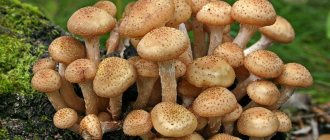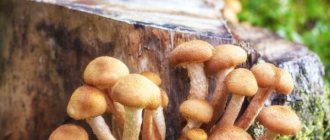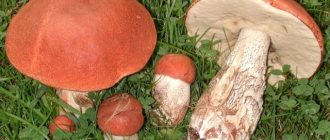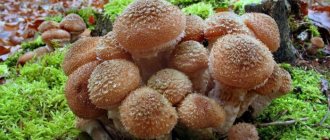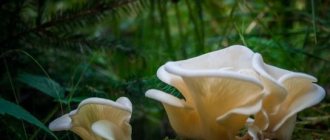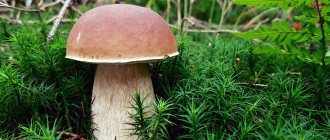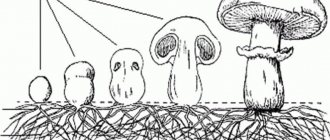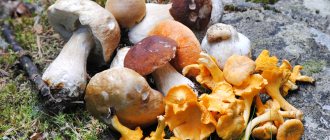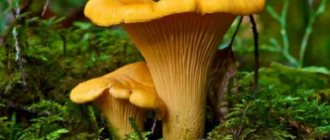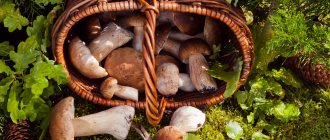Remember the gnome who sat on a fly agaric hat. He so often becomes the hero of fairy tales in some Western countries. His decorative sculptures adorn many parks and attractions around the world.
Mushrooms are very interesting for housewives who create culinary masterpieces. They are of particular interest to a certain category of young people who are addicted to hallucinogens.
Yes, for many it is not easy to pass by even just an image of an unusual specimen of a giant mushroom found by someone.
And when you go to the forest to pick mushrooms, you hope that you too will come across such an unusual find, a really huge mushroom, even a giant. But usually you pick up the most common boletus, boletus, milk mushroom, trumpet and other forest beauties. And some people are much luckier. And then the find becomes the subject of active discussion for a long time and gives hope to subsequent mushroom pickers that such luck awaits them too.
By the way, giant mushrooms are not an anomaly, as biologists believe, and most of them are edible. And they are found in different parts of the world.
Raincoat from England (12th place)
If you have ever claimed to have found a mushroom of incredible size, then you probably have not heard anything about the story of an amateur gardener, British woman Terri Hodson-Walker, who, during one of her walks in the forest, discovered a “non-standard” specimen of puffball or Calvatia gigantea, which had grown due to intense autumn rains to very large sizes.
The weight of the find was about two kilograms. In diameter, its cap was 46 centimeters long. The woman wanted to record an amazing find as the largest mushroom in the world and turned to representatives of the Guinness Book of Records, but she was refused, since similar records had already been described earlier.
Truffle
This find in southern Italy can be considered the most expensive mushroom. If the owner had sold this unique seven-kilogram beauty, he would have earned a lot, because there are no mushrooms in the world more expensive than truffles. But the family enjoyed the fried delicacy.
In certain areas of the country, the search for white truffles, the rarest and most coveted food ingredient in the world, is carried out by dogs specially trained for this purpose only during the last three months of the year. And from time to time there are giants weighing up to two kilograms, most often sold at auctions and tens of thousands of dollars are paid for them.
Lingzhi from China (10th place)
Otherwise, this unusual microorganism is called lacquered polypore (in Latin - Ganoderma lucidum).
A huge mushroom was found near the city of Hezhou. The giant's weight was more than 7.5 kilograms, and the size of his cap was 1 meter 7 centimeters.
Interesting: Polypore or lingzhi is highly valued in Chinese traditional medicine. Otherwise, it is called the “mushroom of immortality” for the presence of active substances in its composition that help improve the function of leukocytes and stimulate the immune system. It has been known in China for more than two thousand years. It is believed that lingzhi infusions help with heart disease, treat cancer, benign tumors, and help restore respiratory function in case of problems with the bronchi or lungs.
Champignon
The real giant was discovered in the Italian province of Baria. A resident of one of the villages near his home came across a huge champignon. The weight of the find reached 14 kg. A thorough examination showed that this giant is quite edible. The champignon was taken home by a lucky mushroom picker and cooked. There were enough dishes from it to arrange a small feast for the inhabitants of the house and their neighbors.
White mushroom from Russia (9th place)
It was discovered by mushroom pickers in the fall of 1961. The news of the discovery of the giant boletus was announced on the radio, but data on its exact location was not preserved.
The large white mushroom weighed more than 10 kilograms. His hat measured about 58 centimeters.
Large boletus mushrooms are not uncommon in the European region. For example, in the Suzdal forest, a mushroom picker from Vladimir found a white mushroom weighing about 2 kilograms, with a head of 30 cm. And, a mushroom picker from the Polish city of Bydgoszcz in 2013 was able to find a specimen weighing 3 kilograms, with a 40-centimeter hat.
Cooking and marinating recipes
Boletus mushrooms are used in various dishes. They do not lose their taste when boiled, fried or salted. In some countries they are eaten raw. Porcini mushrooms do not require long cooking or soaking. When boiled, Borovik does not darken, which allows you to prepare soup with light broth from them. Aromatic mushroom soup is prepared according to the following recipe:
Ingredients:
- 1 cup pearl barley.
- 3 medium sized potatoes.
- 2 carrots.
- 1 onion
- 300g mushrooms.
Cook the pearl barley over low heat until the broth thickens. Mushrooms are fried with onions, and together with chopped potatoes and carrots they are sent to the pan with barley. You can add herbs, bay leaf or pepper to taste. After removing from heat, add a spoonful of butter and let it brew for 20 minutes.
Fried mushrooms
Fresh Boletuses do not lose their aroma when fried. There are many such dishes not only in Russian cuisine. For example, you can cook fried mushrooms according to an old Italian recipe.
Ingredients: fresh boletus, flour, oil (preferably olive) Chop the mushrooms and roll in flour. To create crispy mushrooms, place mushrooms in cold water before frying. After frying in a hot frying pan, blot them with absorbent paper. Sprinkle salt or other seasonings on top and serve hot.
Marinated mushrooms
To store boletus mushrooms for a long time, they are dried, frozen, and salted. In cold winter, you can enjoy delicious pickled mushrooms. For this you will need mushrooms, water, vinegar, salt, peppercorns, bay leaf, garlic, cloves.
Before cooking, wash and chop the mushrooms. Place the Boletus mushrooms in a saucepan with salted water. Bring to a boil, drain the water and cook again. Drain the water and rinse the mushrooms with water. For the marinade, boil 1 liter of water with 1 tablespoon of salt and a little less sugar. Add mushrooms, garlic, bay leaf, pepper, 1 tablespoon of vinegar. Let it simmer for a while and pour into jars.
Not only people love to harvest boletus, but also “forest dwellers”. Squirrels dry them by putting them on twigs and branches. Thus, she can prepare almost a kilogram of mushrooms.
Article viewed: 1,819 Share this post
Raincoat from Russia (8th place)
This giant claims the honorary title: “the largest mushroom in Russia.” The place where it was discovered was a forest in the Perm region. It was found by Vladislav Grabosinsky in 2011.
The record holder had a hat of 1 meter 72 centimeters and weighed more than 12 kilograms.
According to biologists, this find cannot be called exceptional or rare, since puffballs are large mushrooms and, under certain conditions, can reach a weight of 20 kilograms or more.
The giant raincoat was delivered to Perm State University and entered into the Guinness Book of Records.
Features
The fruiting period of the mushroom in temperate climates lasts from June to September, in the southern regions - to October. Individual specimens can be found at the end of May.
Boletus bears fruit in forest clearings in groups (sometimes singly) on loamy, sandy and sandy loam soils. In rare cases, it grows in swamps and peat bogs.
You need to look for it near coniferous and deciduous trees (spruce, pine, oak, birch); it loves forests with lichen or moss cover. It is a light-loving species, but with high yields it can hide in shaded places.
Description of external features:
- The hat has a convex shape. With age it becomes larger and flat-concave. The peel does not separate from the pulp, its color ranges from almost white to red-brown (sometimes the color is uneven, in lemon or orange tones). A yellowish or white rim may be present. The surface is smooth or wrinkled, and in wet weather it is slimy.
- The thick leg is massive and barrel-shaped. The base is thickened, the surface is milky, reddish or brownish with a thin mesh of light veins (sometimes the pattern is weakly expressed).
- The pulp of young specimens is strong, while that of older specimens is fibrous (it turns yellow with age). After cutting, most species do not change shade.
- The tubular layer is easily separated from the cap and is distinguished by a deep recess near the stem. It is white in color, but with age it first turns yellow, then olive.
This species of the Boletaceae family penetrates far into the Arctic zone, growing over a vast territory of Russia from the Kola Peninsula to the Caucasus, from Chukotka to the western regions. It is rare in the tundra and forest-tundra; many myceliums are found in the northern taiga. It grows more often in lowland forests than in mountain forests.
Varieties of porcini mushrooms can be seen not only in Russia, but also in other countries on all continents (except Australia). Among them:
- Iceland;
- British Isles;
- Japan;
- Mongolia;
- China;
- Türkiye;
- Syria;
- Lebanon;
- territories from North America to Mexico;
- from Morocco to North Africa;
- in Europe - from Scandinavia to the southern regions of Italy.
In the southern part of America and Africa, New Zealand, spores are brought with seedlings of coniferous plants.
Champignon from Italy (7th place)
Much-loved champignons are popular mushrooms that are often grown in an artificial environment. In some European countries they are considered a popular agricultural product. It would seem that there is nothing special about them. However, sometimes they reach incredible sizes, like one unusual specimen discovered in Italy.
A real giant, weighing about 14 kilograms, was accidentally found by farmer Francesco Quito, who lived in the province of Baria. To move the find to the house, he needed a car.
After the huge mushroom was cut, it turned out that it was completely edible and did not contain worms. So the farmer decided to share this delicacy with friends and neighbors by roasting it for dinner.
The largest mushrooms in Europe
Today, there are about one hundred thousand varieties of mushrooms, among which there are specimens with healing properties. Some of them contain penicillin and antibiotics. And, of course, the fruits are widely consumed.
Europe is rich in mushroom places, but giants are extremely rare. Scientists have not yet figured out the reason for the growth of fruits to unimaginable sizes.
Champignon
Of all the huge mushrooms ever found in European countries, the champignon ranks first. Italian Francesco Quito discovered a 14-kilogram fruit in a field near the province of Bari. The farmer and his wife loaded the find onto the car. They brought the giant home, cleaned it, cooked it, and invited friends and neighbors to the table.
Champignons in the wild generally grow no more than 25 cm in height. Adult fruits have a flat cap, while young ones have a round cap. The surface color can be white, brownish or brown. At the beginning of growth, the plates are painted white, and as they mature, the color changes to pink or almost black.
Champignon
Honey fungus
In eastern Switzerland, scientists have discovered a huge mushroom mycelium that is more than 1000 years old. In Europe, this is the largest mushroom, the size of which varies between 800×500 m. As is known, honey mushrooms form mycorrhiza with rhizomes, which has a detrimental effect on trees.
Honey fungus
The honey fungus has a relatively small size: the cap is up to 17 cm in diameter, the leg is up to 10 cm in height. The surface comes in various shades of brown or olive greenish. The skin is covered with light scales, which may disappear as they grow.
Truffle
A huge white truffle was discovered in Italy. The weight of this delicacy reached 1.89 kg. The difficulty of hunting for this delicacy mushroom is that it grows underground and can only be found with the help of specially trained dogs. The truffle was put up for auction and sold for 61 thousand dollars.
Truffle
The fruit has a tuberous or round shape. The pulp is fleshy or cartilaginous. The size varies from a small nut to a large potato tuber. You can find truffles in deciduous forests, because they form mycorrhizae with the rhizomes of trees. White truffle most often grows near poplar, rowan, elm, linden and birch.
Tree mushroom from Spain (6th place)
This unusual specimen, belonging to the family Meripilus giganteus, claims to be one of the largest edible mushrooms in the world.
This giant, weighing 68.8 kilograms, was found by Spanish mycologist Sergio Martinez Valledor. Initially, he decided that this was the so-called “chicken mushroom” or Laetiporus sulphureus, with a delicious taste reminiscent of the meat of this bird. But, after a detailed study, it was found out that this is a gigantic meripilus, otherwise called a “tree mushroom.”
It is interesting that among the Myripilus there were previously quite large exhibits. For example, tree mushrooms weighing about 45 kilograms are known to have been discovered.
To remove the mushroom, which was firmly attached to the bottom of the tree, Valledor had to attract a team of assistants. They sawed it into two parts and delivered it to its destination in this form.
Giants of Russia
When talking about picking mushrooms, of course, most people mean definitely edible mushrooms that have a familiar shape, color and delicious smell, and not those varieties that frighten you just by their appearance, and you need to cook them with the care of a chef from Japan who conjures fugu fish
First of all, these are mushrooms whose names are familiar from childhood, and whose collection experience goes back centuries:
- Boletus. The most recently described case of finding a giant specimen, about which there was a short TV report on the Rossiya TV channel, occurred in 2011 in the Omsk region. Alexey Korol, a mushroom picker with considerable experience, found a mushroom with a cap diameter of 36 cm. The height of the giant’s leg is 28 cm, weight is 2.4 kg. What was especially surprising and pleasing about the find was that it turned out not to be wormy.
- Mushroom, which many mushroom pickers consider the only one worthy of pickling. Mentions of preparation methods can be found even in monastery chronicles. By the way, in the West it is considered inedible. The mushroom is very dense, so even with its small size it is quite weighty. Unfortunately, there were no reliable facts about the record load. It is only known that the cap is 25 cm in diameter; almost a kilogram weight is not the limit for it.
- Ryzhik. The second most important mushroom for pickling, but it also has an excellent taste when fried. You can also salt it and bake it over a fire right in the forest. The cap is 20 cm, the weight is about 0.5 kg - the limit for an edible specimen, which no one has ever enjoyed before the mushroom picker.
- Oil can. Those who have at least once tasted the taste of butter potatoes fried with onions, are happy to collect them in clean coniferous forests. This mushroom is not striking in size. Unfortunately, it is highly valued not only by people, but also by forest dwellers, from worms to squirrels. Therefore, you should not wait for record sizes, but send the boletus into the basket.
- The porcini mushroom or boletus mushroom is the dream of many, the king of Russian forests. The mushroom is very dense, with a rich (even dried) smell. There is information about the discovery in 1961 in a forest near Moscow of a porcini mushroom with a 60-centimeter cap, weighing about 11 kg, which is impressive. Today this is the largest white mushroom in the world, but nothing lasts forever, and a new record is waiting for its lucky owner.
Some facts:
- Fungi are living organisms, and not lower plants, as previously thought. At the same time, they combine some characteristics of animals and plants.
- There are more than 100 thousand different species, of which macromycetes are of interest to lovers of quiet hunting.
- These are cap mushrooms with massive fruiting bodies that are so nice to put in a basket. These also include puffballs and tinder mushrooms, which, as they say, are not for everyone. A separate species, a variety of “macromycete” mushrooms, as they like to mindlessly label the find in many photographs, does not exist.
- Of all the others, the only thing of interest to lovers of forest walks is the medicinal birch mushroom - chaga, which is not difficult to find; yeast, which was used to make dough for pies on the road; kombucha, which gives a sour drink that perfectly quenches thirst after a quiet hunt.
- Scientists divide all cap mushrooms, which are of the greatest interest to mushroom pickers, into two more groups: basidiomycetes and marsupials.
- For example, boletus, boletus, milk mushroom, oiler, honey fungus, saffron milk cap are basidial, and the famous truffle and mushrooms with unpleasant names: morel, string - are marsupial mushrooms.
Macrocybe Titans and Titan Tricholoma from the USA (5th place)
The first description of this species in the scientific literature dates back to 1980. Previously, representatives of this family were called Ryadovka, but in 1998, as a result of research and study, seven species from this family were assigned to the new genus Macrocybe.
Their natural habitat is the United States of America and the Caribbean region. One of these large mushrooms, weighing more than 28 kilograms, was discovered in 2005 by a mycologist from Mexico named Rene Andrade. Its habitat was a coffee plantation, where this microorganism grew to enormous sizes.
This is interesting: Under normal conditions, the size of the hard lamellar caps of mushrooms of this species, which resemble chanterelles, does not exceed 50-100 cm. When young, the color of the cap is darker, and when mature it becomes almost white. By nature, mushrooms are saprophytes that grow in areas with degraded, poor soil.
Later, similar giant Macrocybe Titans mushrooms were discovered in Mexico in 2007. The largest specimen with a cap of 70 cm weighed about 20 kilograms.
LiveInternetLiveInternet
A special form of life that harmoniously combines animal and plant characteristics, mushrooms are one of the most ancient and amazing inhabitants of our planet. In addition, this complex living organism, like an iceberg, shows us only a small part of its body. Let's try to look at these unusual living organisms and find out what the largest mushroom in the world is. VERY LARGE MUSHROOMS First, let’s look at several species that are rightfully considered the largest mushrooms in the world...
Honey mushroom / Armillaria
In Western Europe and the USA they are usually called Armillaria, but in Russia the name honey mushroom has taken root.
The name of a large genus of mushrooms is translated from Latin as “bracelet”. In total, 17 species of these agaric mushrooms grow on the planet, and below we will talk about the record holders for the size and area of this type of mushroom.
Giant loggerhead / Calvatia gigantea
One of the largest and most unusual mushrooms from the huge Champignon family. They have an original spherical mycelium shape, and grow in almost any environment, from deciduous forests to meadows and pastures.
When young, this species is edible and is widely used in cooking in many countries around the world. But the spores of Calvatia gigantea are a valuable raw material in medicine for the production of many types of medicines.
White mushroom / Boletus edulis Boletus,
The most popular and recognizable type of mushroom in the vast expanses of Russia is also called boletus, which is why an old boletus with a mushroom cap on its head appeared in fairy tales.
White mushroom / Boletus edulis
The mushroom has been known since ancient times, and in Ancient Rome it was considered a tasty delicacy, and today it is considered one of the best in cooking in terms of its taste.
Polypores
The status of the species name for these mushrooms has not yet been determined, but the fact that they grow in enormous sizes has been noticed since the end of the 19th century.
They all have different shapes and grow on tree trunks and stumps. Their diversity amazes mycologists, and some types of polypores can grow up to 1.5 m and weigh more than 10 kg. Record-breaking mushrooms And now let’s look at the record-breaking mushrooms that mushroom pickers were lucky enough to discover in different parts of our planet, and these finds made successful mushroom pickers famous throughout the world...
Raincoat from England Calvatia gigantea
discovered by a young British woman named Terry, who immediately became a local celebrity. After the rain, while walking through the forest, she came across a huge raincoat. Having measured the cap, it turned out that its diameter was 46 cm, and the weight of the mushroom itself was 2 kg. The British woman submitted an application to the Guinness Book to recognize her find as the largest mushroom in the world, but it was rejected, as history knows of larger specimens of this species. This species is quite popular, but it is quite difficult to find large specimens, since before the mushroom pickers arrive, they become a delicacy for animals. By the way, some animals can go for a very long time without food. Find out who this is on the pages of our website thebiggest.ru by following the link.
Russian boletus
An avid mushroom picker from the Tomsk region once discovered a huge boletus mushroom, whose weight was 2.4 kg. Naturally, the mushroom was measured in all respects. The length of the leg of this miracle was 28 cm, and the diameter of the cap was 36 cm. The find of the mushroom picker was reported on the news of the Rossiya TV channel, stating that such a giant turned out to be not worm-eaten, and could well go into soup or a frying pan.
Lingzhi from China
A huge mushroom from the genus Ganoderma lucidum was discovered in one of the provinces of China near the town of Hezhou. In the world it is known under the name Lacquer tinder, and the Chinese call it Lingzhi. The giant weighed 7.5 kg, and the diameter of the cap was 107 cm. This tinder fungus has long been used in traditional Chinese medicine. And its beneficial properties were known back in the 1st millennium BC. Due to effects on human immunity. The Chinese also call it the “Mushroom of Immortality.”
White mushroom of Russia
The largest white mushroom in Russia was found in 1961, and if history has preserved its weight and size, time has erased the location of its discovery. This beautiful giant weighed 10 kg, and the diameter of the cap was 58 cm. The find was reported on the radio, after which the number of mushroom pickers increased significantly. The second record holder was found on Seliger in 2010, a photo of which we post on the website.
Russian raincoat
In the Perm region in 2011, Vladislav Grabosinsky found a raincoat that was larger than the British one in size and weight. The diameter of the spherical mushroom was 1.72 m and it weighed 12 kg. It was already too late to eat this miracle of nature. And Vladislav gave his find to Perm University. After the discovery was made public, mycologists said that this was not uncommon, but they could not provide a mushroom of this species of a larger size, so the “Perm Raincoat” took its place of honor in the Guinness Book of Records.
Champignon from Italy
Francesco Quito and the largest champignon in Italy A resident of the Italian province of Baria, Francesco Quito, was very surprised when he discovered a huge champignon. With difficulty he brought it home, the Italian weighed the find, and the scales showed 14 kg, which became an Italian record. Despite its size and age, the mushroom turned out to be quite edible, and Francesco called the village residents to help him eat the unique and tasty find.
Macromicent from China
Known as cap mushrooms, they form large colonies on the ground or trees that are easily visible to the naked eye. A huge macromycent of an unusual shape was discovered in one of the Chinese provinces. The fact is that in shape it was more like hundreds of small mushroom caps that grew on one stem. The weight of the find was 15 kg, and the diameter of the mushroom was 1 m. Note that scientists have not yet decided on the type of such an unusual mushroom.
Titan tricholoma from the USA Macrocybe titans
The species Macrocybe titans was first described in 1980, and in 2005, mycologist from Mexico Rene Andrade found a mushroom of this species on a coffee plantation in the United States that weighed 28 kg. Two years later, a similar mushroom was found in one of the southern Mexican states, 70 cm high and weighing 20 kg. Such specimens aroused keen interest from the scientific community. Note that these unique mushrooms grow in the southern states of the United States and Central America. Hello pikabushniks!
Macromycete from Canada Raincoat
Canadian resident Christian Therrien was very surprised when, as they say, a huge puffball mushroom grew on his way. Christian just decided to take a walk in the woods with his son, and then this happened. After weighing his find, the Canadian learned that the weight of the miracle of nature was 26 kg. When the giant raincoat ended up inside the house, the whole family and neighbors had fun photo sessions with it, because it’s not every day that you come across such huge mushrooms.
Fomitiporia ellipsoidea from China
One of the varieties of a polyporous mushroom of enormous size was discovered in the vast expanses of China on the island of Hainan in 2010. After being studied by Chinese mycologists, it turned out that this is the largest mushroom fruiting body in the world, weighing more than 500 kg. When discovered, the height of the giant tinder fungus was 10.85 m, and the diameter of the mushroom cap was 88 cm. Scientists stated that it had been growing for about 20 years, but it was not immediately possible to detect it, since the growth process took place underground for a long time. The largest myceliums We have already mentioned that most of the fungus is underground, and it’s time to introduce the largest terrestrial organisms on the planet...
Honey fungus in Switzerland
Not far from the Ofen mountain pass in a national park in Switzerland, a mycelium of the species Armillaria ostoyae was discovered, which is currently the largest in Europe. It extends over an area of 35 hectares and is believed by mycologists to be approximately 1,000 years old. This is how ordinary honey mushrooms, small in size, hid such a gigantic organism underground.
Washington State Monster Mushroom
In early April 1992, the New York Times published an article about a huge mushroom of the genus Armillaria discovered in Washington state. The weave of threads underground extended over an area of 15 hectares. Scientists were able to prove that all this is one living organism, and this was the first report of its kind about the enormous size of mushrooms. Just a few months later, a similar mushroom was discovered again in the United States, growing over an area of 6 km².
Oregon Giant
The mycelium of the honey fungus, also known in the world under the name honey mushroom, was considered the largest living organism. It developed, according to biologists, over 2,400 years, and today is located within the Malheur National Forest in Oregon. Naturally, superlative epithets were attached to him - “monster honey fungus”, “Oregon monster”. In 1998, it was possible to determine that the accumulation of mushrooms on the territory of the reserve is one living organism, occupying an area of 880 hectares.
A real record holder
In early October 2022, scientists announced that the honey fungus, found in the US state of Michigan, is the largest living organism on the planet. Scientists have confirmed that it began to develop as a microorganism from a small spore, and over time it reached such a gigantic size. Most of it is underground, and its age is 2.5 thousand years. It was possible to determine the approximate weight, which is 400 tons. So, the blue whale will be thrown off its pedestal as the largest living organism on the planet.
Summarize
The largest mushrooms As you can see, mushrooms are truly a miracle of nature, which sometimes amazes with their size. Naturally, it is not always possible to find giants in the forest, but clearings of medium and small mushrooms are also pleasing to the eyes of avid mushroom pickers. Author of the article: Valery Skiba https://thebiggest.ru/priroda/samye-bolshie-griby.html
Macromycete from Canada (4th place)
Amazing record-breaking mushrooms have been repeatedly discovered on the North American continent. One of them, a huge raincoat weighing more than 26 kilograms, was discovered while walking through the forest by Canadian Christian Therrien.
The man admitted that he had never seen such “giant mushrooms” before, so he took the find home to show it to his friends and take a photo with the unique exhibit.
general information
Today people know more than one hundred thousand species of these organisms. A certain percentage of them bring a lot of benefits to a person. Therefore, in all corners of the planet - in the USA and Russia, in Australia and Brazil - the edible mushroom is the basis of a variety of dishes. The product is used in the following areas:
- Food sector: winemaking, production of fermented milk products, bakery and confectionery products.
- Medical industry: penicillin is produced from mushrooms. as well as other medications and antibiotics.
They are partially used in veterinary medicine as medicine, and also as raw materials for the production of medicines.
Chinese macromycete (3rd place)
A distinctive feature of this unique microorganism, discovered in the Chinese region of Yunnan, in addition to its exceptional size, is its non-standard shape for its species.
It seemed to consist of several hundred “mini” caps, fused together, growing from a common stem. The hat at its widest point was about 100 centimeters wide. The weight of the unusual exhibit was 15 kg.
The amazing “multi-headed” mushroom has often been photographed in various scientific and entertainment publications. At the moment, it is not included in any classifications, but this does not prevent it from claiming the title of one of the largest representatives of the genus of macromycetes.
Fomitiporia ellipsoidea from China (2nd place)
In the ranking of the largest mushrooms in the world, it is worth noting a specimen from Hainan, found during mycological research in 2010.
The unique exhibit Phellinus ellipsoideus, weighing about 500 kilograms, was twenty years old, having managed to grow to a record height of 10.85 meters during this period, growing an 88-centimeter hat.
According to one of the scientists who studied the find, Professor Yu Cheng Dai, similar huge mushrooms were found earlier, in 2008, in Fujian province, but they were still far from the size of the find from Hainan.
It was found by accident, and at first the researchers could not understand what was in front of them: a giant mushroom or another formation. Visualization of the microorganism was difficult due to the fact that most of it grew underground. For this reason, they simply did not pay attention to him.
Interesting Facts
There are many very interesting and entertaining things about mushrooms. For example, in Japan, biologists made an amazing statement that mushrooms can think and remember, and the mycelium, due to its uniqueness, is called the underground “Internet”.
The most interesting thing is that the mycelium itself grows endlessly, sometimes reaching enormous sizes. 10 years ago, a mushroom network was found in one of the US states; it stretched underground over almost 900 hectares, which is equal to approximately 1800 football fields. Knowing that the mycelium is the vegetative body of a fungus, we can say that the discovery is the largest mushroom in the whole world.
Armillaria ostoyae from the USA (1st place)
Armillaria ostoyae (dark honey mushroom), deservedly leading the top of the giant mushrooms, is recognized as the most gigantic microorganism on the planet. Its habitat is the forests of Oregon (USA).
Its shoots, growing above the surface of the earth, look like small enough mushrooms that easily fit in the palm of an adult. Another thing is the mycelium, which has spread over an area of more than 880 hectares.
This is interesting: the area of the measured mycelium Armillaria ostoyae is so large that it is enough to completely cover more than 1,600 football fields. This is an exceptional case in history. Its formation took place over 2.5 thousand years. During this period, the “tentacles” of the fungus actively spread throughout the Oregon forests, preventing other plants from fully developing. According to scientists, the weight of this specimen is more than 600 kilograms.
In addition to the giant colony of the “Oregon monster,” scientists have discovered other colonies of colossal size that are worthy of mention on our list. These included:
- Mushrooms from Switzerland, which have formed a mycelium with a total area of more than 35 hectares on the territory of the natural park in the Ofena Pass area. The estimated age of this giant is about a thousand years. This mycelium is the oldest on the European continent.
- Mycelium from the American state of Washington, with a total mycelium area of more than 600 hectares. It was found by chance during terrain research in 1992.
Giant colonies of honey fungus are a real problem for American scientists. In addition to its scientific value, this microorganism poses a serious threat to Oregon forests, since when it grows rapidly, it deprives native trees and other vegetation of their natural habitat. Therefore, they are actively developing programs to control its spread throughout the United States.
The uniqueness of the largest mushrooms in the world
Scientists say that giant mushrooms are not an anomaly. Under certain circumstances, each representative of the mushroom kingdom can grow truly huge. At the same time, some species (for example, Armillaria) are also genetically predisposed to this.
A giant mushroom, like any other, grows as a collection of cells that gather into a thread of mycelium (mycelium). As this system matures, enormous pressure is created in the cells (700-750 t/m²). Hyphae threads perform the function of the gastrointestinal tract. They secrete enzymes, breaking food molecules into components and consuming the necessary substances.
Interesting! Fungi actually grow inside the food they ingest. This is a unique nutritional property that allows, under favorable conditions, to reach colossal sizes.

